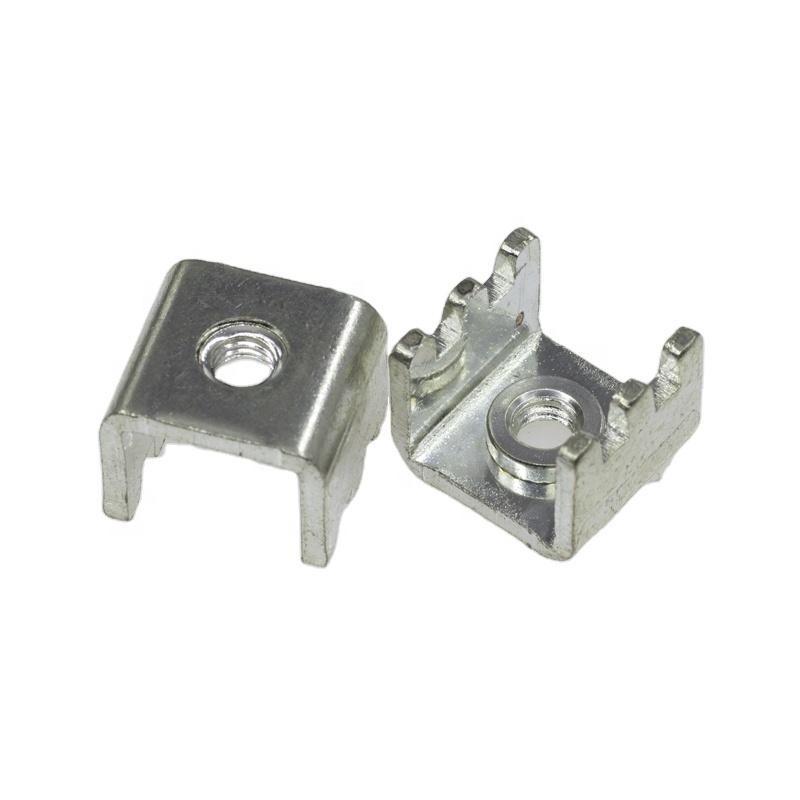When punching and flanging in metal stamping, the deformation area is basically limited within the fillet of the die. Under the action of unidirectional or bidirectional tensile stress, the tangential elongation deformation is greater than the radial compression deformation, resulting in material thickness reduction. The mouth of the vertical edge of the flanging hole is thinned to the maximum. When the thickness is thinned too much and the material elongation exceeds the limit elongation of the material, the so-called p fracture occurs (the crack caused by excessive elongation and insufficient plasticity of the material is called force anus fracture; the crack caused by excessive forming force and insufficient strength of the material is called a fracture). When punching and flanging, the smaller the flanging coefficient K, the greater the degree of deformation, and the greater the thickness reduction of the vertical edge mouth, the easier it is to crack. Therefore, the thickness reduction of the vertical edge mouth cannot be ignored when flanging.
1.Cracks occur on the circumference of the punched hole opening. The main reason is that the punched pre hole section has tear surface and burr, where there is a stress concentration point. During the hole turning process, the plasticity of this place is poor and it is easy to crack. The use of materials with good elongation can increase the deformation degree of the punching hole flanging and reduce the hole flanging cracking. If the forming is allowed, the pre hole diameter shall be increased as much as possible to reduce the deformation of the hole, which is helpful to reduce the cracking of the hole. If the structure allows, thin materials shall be used as far as possible to increase the relative diameter (D 0/t) of the pre hole, which is helpful to reduce the probability of hole turning cracking. When designing the mold, it is better to adopt parabolic or spherical shape for the flanging punch, which can increase the allowable deformation of local materials and reduce cracking. During stamping, the direction of punching and flanging can be opposite to that of punching and pre drilling, so that the burr is located inside the flanging, which can reduce cracking.
2. After the stamping and flanging hole is closed, the hole shrinks, the flange is not vertical, and the hole diameter becomes smaller, which will make it difficult to screw during assembly. The main reasons for necking are material springback, and the gap z/2 between punch and die is too large. The material with good performance is used in production, with small rebound, which can improve the necking problem. When designing the die, selecting the appropriate clearance between the male and female die can ensure that the flanging flange is vertical. The clearance between the punch and the die is generally slightly less than the material thickness.
3. The insufficient height of the flanging flange directly reduces the screwing length of the screw and the hole and affects the reliability of the screw connection. The factors that affect the flange height of stamping flanging include excessive pre hole diameter, etc. Select a smaller hole diameter for pre punching to increase the height of hole turning. When the pre hole diameter cannot be reduced, the thinning and flanging can be adopted to make the wall thinner to increase the height of the flanging flange.
4. The root R of punching and flanging is too large. After flanging, the root R is too large, which will cause that a considerable part of the root has no contact with the screw during assembly, reducing the screw in length of the screw and the hole, and reducing the reliability of the screw connection. The root R of flanging hole is too large, which is related to the material thickness and the entrance fillet of stamping flanging die. The thicker the material is, the larger the root R will be; The larger the fillet at the entrance of the die, the larger the R at the root of the flanging hole. To reduce the root R of flanging hole, thin materials should be selected as far as possible. When designing the die, small fillets at the entrance of the female die should be designed. When thicker materials are used or the fillets at the entrance of the female die are less than 2 times the material thickness, the flanging punch shall be designed to increase the shoulder with shaping, and the root R shall be shaped at the end of the stamping stroke, or the shaping process shall be added separately.
5. When punching and flanging holes are processed by punching and flanging waste materials, there is no corresponding structure matching on the concave die during punching, and the materials are pulled off. The punching waste materials may randomly adhere to the edge of the hole, resulting in frequent punching waste materials. The vibration of the waste materials during picking up and handling is easy to scatter on the working surface of the die or the part, causing indentation defects on the surface of the part, which requires manual repair, It is difficult to meet the requirements for external parts to be repaired, and they can only be scrapped, wasting manpower and materials; The waste materials of flanging holes, if brought to the general assembly, are easy to cut the operators and affect the screwing; For electrical parts, such as flanging hole waste, it is easy to cause short circuit when it falls into electrical components during screwing, which will lead to electrical safety problems.
Post time: Dec-17-2022

